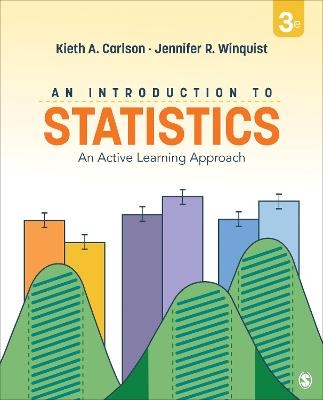
An Introduction to Statistics
SAGE Publications Inc (Verlag)
978-1-5443-7509-0 (ISBN)
This updated and reorganized Third Edition of this textbook takes a workbook-style approach that encourages an active approach to learning statistics. Carefully placed reading questions throughout each chapter allow students to apply their knowledge right away, while in-depth activities based on current behavioral science scenarios, each with problem sets and quiz questions, give students the opportunity to assess their understanding of concepts while reading detailed explanations of more complex statistical concepts. Additional practice problems further solidify student learning. Most activities are self-correcting, so if a concept is misunderstood, this misunderstanding is corrected early in the learning process. After working through each chapter, students are far more likely to understand the material than when they only read the material.
Kieth A. Carlson received his PhD in Experimental Psychology with an emphasis in Cognitive Psychology from the University of Nebraska in 1996. He is currently Professor of Psychology at Valparaiso University. He has published research on visual attention, memory, student cynicism toward college, and active learning. He enjoys teaching a wide range of courses including statistics, research methods, sensation and perception, cognitive psychology, learning psychology, the philosophy of science, and the history of psychology. Dr. Carlson was twice honored with the Teaching Excellence Award from the United States Air Force Academy. Jennifer R. Winquist is currently Professor of Psychology at Valparaiso University. Dr. Winquist received her PhD in Social Psychology from the University of Illinois at Chicago and her bachelor’s degree in Psychology from Purdue University. She has published research on self-focused attention, group decision making, distributive justice, and the scholarship of teaching and learning. Dr. Winquist regularly teaches courses in introductory and advanced statistics and research methods.
Preface
Acknowledgments
About the Authors
Part 1: Descriptive Statistics and Sampling Error
Chapter 1: Introduction to Statistics and Frequency Distributions
How to Be Successful in This Course
Math Skills Required in This Course
Statistical Software Options
Why Do You Have to Take Statistics?
The Four Pillars of Scientific Reasoning
Populations and Samples
Independent and Dependent Variables
Identify How a Variable Is Measured
Graphing Data
Shapes of Distributions
Frequency Distribution Tables
Chapter 2: Central Tendency and Variability
Frequency Distribution Graphs and Tables
Central Tendency: Choosing Mean, Median, or Mode
Computing Measures of Central Tendency
Variability: Range or Standard Deviation
Steps in Computing a Population’s Standard Deviation
Steps in Computing a Sample’s Standard Deviation
Constructing a Scientific Conclusion
Chapter 3: z scores
Computing and Interpreting z for a Raw Score
Finding Raw Score “Cut Lines”
Finding the Probability of z Scores Using the Standard Normal Curve
Positive z Score Example
Negative z Score Example
Proportion Between Two z Scores Example
Chapter 4: Sampling Error and Confidence Intervals with z and t Distributions
Sampling and Sampling Error
The Central Limit Theorem and the Standard Error of the Mean (SEM)
Applying the SEM to Find Statistical Evidence
Part 2: Applying the Four Pillars of Scientific Reasoning to Mean Differences
Chapter 5: Single sample t, effect sizes, and confidence intervals
Four Pillars of Scientific Reasoning
Apply the Four Pillars of Scientific Reasoning
Construct a Well-Supported Scientific Conclusion
Chapter 6: Related samples t, effect sizes, and confidence intervals
Related Samples t Test
Logic of the Single Sample and Related Samples t Tests
Apply the Four Pillars of Scientific Reasoning
Construct a Well-Supported Scientific Conclusion
Chapter 7: Independent samples t, effect sizes, and confidence intervals
When to Use the Three t Tests
The t Test Logic and the Independent Samples t Formula
Apply the Four Pillars of Scientific Reasoning
Construct a Well-Supported Scientific Conclusion
How to Interpret High p Values
Chapter 8: One-way ANOVA, effect sizes, and confidence intervals
Independent Samples One-Way ANOVA
Logic of the ANOVA
Apply Four Pillars of Scientific Reasoning
Chapter 9: Two-way ANOVA, effect sizes, and confidence intervals
Purpose of Two-Way ANOVA
Logic of Two-Way ANOVA
Apply Four Pillars of Scientific Reasoning
Part 3: Applying the Four Pillars of Scientific Reasoning to Associations
Chapter 10: Correlations, effect sizes, and confidence intervals
When to Use Correlations
The Logic of Correlation
Interpreting Correlation Coefficients
Spearman’s (rs) Correlation
Correlation Does Not Equal Causation: True but Misleading
Apply the Four Pillars of Scientific Reasoning
Construct a Well-Supported Scientific Conclusion
Chapter 11: Chi square and effect sizes
When to Use X2 Statistics
Logic of the X2 Test
Apply the Pillars of Scientific Reasoning
Construct a Well-Supported Scientific Conclusion
Apply the Pillars of Scientific Reasoning: X2 for Independence
Appendices
References
Index
| Erscheinungsdatum | 04.02.2021 |
|---|---|
| Verlagsort | Thousand Oaks |
| Sprache | englisch |
| Maße | 187 x 231 mm |
| Gewicht | 910 g |
| Themenwelt | Geisteswissenschaften ► Psychologie |
| Mathematik / Informatik ► Mathematik ► Statistik | |
| ISBN-10 | 1-5443-7509-3 / 1544375093 |
| ISBN-13 | 978-1-5443-7509-0 / 9781544375090 |
| Zustand | Neuware |
| Haben Sie eine Frage zum Produkt? |
aus dem Bereich


